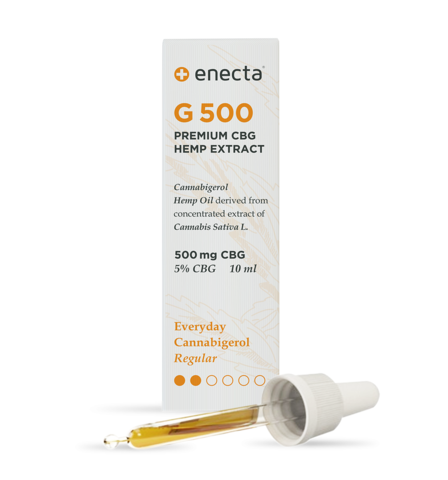Borrelli, F., et al. "Colon carcinogenesis is inhibited by the TRPM8 antagonist cannabigerol, a Cannabis-derived non-psychotropic cannabinoid." Carcinogenesis, vol. 35, no. 12, 2014, pp. 2787-2797.
Brighenti, V., et al. "Development of a new extraction technique and HPLC method for the analysis of non-psychoactive cannabinoids in fibre-type Cannabis sativa L. (hemp)." Journal of Pharmaceutical and Biomedical Analysis, vol. 143, 2017, pp. 228-236.
Brierley, D.I., et al. "Cannabigerol is a novel, well-tolerated appetite stimulant in pre-satiated rats." Psychopharmacology, vol. 233, no. 19-20, 2016, pp. 3603-3613.
Cascio, M.G., et al. "Evidence that the plant cannabinoid cannabigerol is a highly potent α2-adrenoceptor agonist and moderately potent 5HT1A receptor antagonist." British Journal of Pharmacology, vol. 159, no. 1, 2010, pp. 129-141.
Citti, C., et al. "Analysis of cannabinoids in commercial hemp seed oil and decarboxylation kinetics studies of cannabidiolic acid (CBDA)." Journal of Pharmaceutical and Biomedical Analysis, vol. 149, 2018, pp. 532-540.
Colasanti, B.K. "A comparison of the ocular and central effects of Δ9-tetrahydrocannabinol and cannabigerol." Journal of Ocular Pharmacology and Therapeutics, vol. 6, no. 4, 1990, pp. 259-269.
Deiana, S. "Potential Medical Uses of Cannabigerol: A Brief Overview." Handbook of Cannabis and Related Pathologies, 2017, pp. 958-967.
EFSA Panel on Dietetic Products, Nutrition and Allergies (NDA). "Scientific Opinion on the safety of hemp (Cannabis genus) for use as animal feed." EFSA Journal, vol. 9, no. 3, 2011, p. 2011.
Ewing, L.E., et al. "Hepatotoxicity of a Cannabidiol-Rich Cannabis Extract in the Mouse Model." Molecules, vol. 24, no. 9, 2019, p. 1694.
Fellermeier, M., et al. "Biosynthesis of cannabinoids: Incorporation experiments with 13C-labeled glucoses." European Journal of Biochemistry, vol. 268, no. 6, 2001, pp. 1596-1604.
Granja, A.G., et al. "A Cannabigerol Quinone Alleviates Neuroinflammation in a Chronic Model of Multiple Sclerosis." Journal of Neuroimmune Pharmacology, vol. 7, no. 4, 2012, pp. 1002-1016.
Mead, A. "Legal and Regulatory Issues Governing Cannabis and Cannabis-Derived Products in the United States." Frontiers in Plant Science, vol. 10, 2019, p. 697.
Millar, S.A., et al. "A Systematic Review on the Pharmacokinetics of Cannabidiol in Humans." Frontiers in Pharmacology, vol. 9, 2018, p. 1365.
Nachnani, R., et al. "The Pharmacological Case for Cannabigerol." Journal of Pharmacology and Experimental Therapeutics, vol. 376, no. 2, 2021, pp. 204-212.
Navarro, G., et al. "Cannabigerol Action at Cannabinoid CB1 and CB2 Receptors and at CB1-CB2 Heteroreceptor Complexes." Frontiers in Pharmacology, vol. 9, 2018, p. 632.
Oláh, A., et al. "Cannabidiol exerts sebostatic and antiinflammatory effects on human sebocytes." Journal of Clinical Investigation, vol. 124, no. 9, 2014, pp. 3713-3724.
Pavlovic, R., et al. "Quality Traits of "Cannabidiol Oils": Cannabinoids Content, Terpene Fingerprint and Oxidation Stability of European Commercially Available Preparations." Molecules, vol. 23, no. 5, 2018, p. 1230.
Pellati, F., et al. "New Methods for the Comprehensive Analysis of Bioactive Compounds in Cannabis sativa L. (hemp)." Molecules, vol. 23, no. 10, 2018, p. 2639.
Riboulet-Zemouli, K., et al. "Cannabis and the Convention on Psychotropic Substances." Drug Science, Policy and Law, vol. 5, 2019, pp. 1-15.
Russo, E.B. "The Case for the Entourage Effect and Conventional Breeding of Clinical Cannabis: No "Strain," No Gain." Frontiers in Plant Science, vol. 9, 2019, p. 1969.
Valdeolivas, S., et al. "Neuroprotective properties of cannabigerol in Huntington's disease: studies in R6/2 mice and 3-nitropropionate-lesioned mice." Neurotherapeutics, vol. 12, no. 1, 2015, pp. 185-199.




































